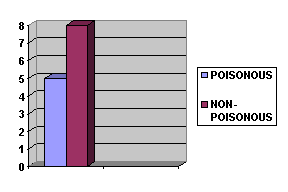Lesson 2








Title: Making Graphs
Objective:
Students
will take a virtual field trip to the Everglades, after which they
will categorize the snakes of the Everglades. They will
make two different graphs. One graph will represent poisonous and
non-poisonous snakes and the other will represent snakes that live on land and
those that live in water.
Materials:
- Computer with Internet access
- Student's Everglades
Journal
- Microsoft Word or Works
Activities:
- Students will visit
Everglades Information Network and Everglades
Snakes
- Students will use
the online search to look up the snakes of the Everglades.
- Students will
take notes in their Everglades Journals and they will keep a list of snakes
and their
traits.
- Examples:
*The brightly colored, very poisonous, eastern coral snake, with
its red, yellow, and black rings and black snout, warns predators
- "stay away from me, I'm dangerous."
*Both the scarlet and scarlet king snake imitate the coral snake
in appearance and are found in the same habitat. All three species
have red, black and yellow rings, but the scarlet and scarlet king
have red snouts. Another difference is that in the coral snake,
the red and yellow rings touch. The scarlet and scarlet king
snakes have their red and yellow rings separated by black.
*The Everglades rat snake is brilliant orange with four dark
stripes; the corn snake has reddish blotches with a black border
in a background of gray, tan, yellow, or orange; and the common
yellow rat snake has four black stripes on a bright golden yellow
background. It is not poisonous.
*The striped crayfish snake is considered the best swimming snake
in Florida, but you're not likely to see one unless you look
carefully among the marsh plants in the northern part of the park.
Much more common is the brown water snake which is the most
frequently seen snake along the Anhinga Trail. People often
mistake it for the poisonous Florida cottonmouth which is found in
the same area. The water snake, if cornered or mistreated, will
bite - but it is not poisonous.
*While most of the snakes living in or near the water are adapted
to a fresh water environment, some, like the cottonmouth and
mangrove salt marsh snake, can survive in the mangrove swamps and
salt water marshes.
- Students will then
compile their list of snakes and categorize them into groups: poisonous,
non- poisonous, living on land and living in water.
- Students will use
the spreadsheet application in Works or Word to enter snake data. They will
then use this data to create two bar graphs of
snakes. They will use this information to compare the four groups.
See the example below:
Graph
of Everglades Poisonous and Non-Poisonous Snakes

Evaluation:
Using students'
completed graphs, assess students on their ability to construct the graph and
interpret the results correctly by comparing data.
Extension: Create
a Guide to Everglades Birds and Upload as Web Pages
-
Teacher- from local
library, check out Peterson's Field Guide to Birds and on Internet
book mark: White
Pelican, Roseate
Spoonbill and Everglades
Ecosystem- click an Animal Profiles
-
Break students into
groups to research the characteristics and lifestyles of the birds of the
Everglades and their adaptations.
-
Copy video clips,
photos and scanned resources
-
Organize data into
Web pages. Teacher should be familiar with simple Web page design (Claris
Homepage, FrontPage, Netscape); talk to school web master.
-
Share their
findings in oral reports as a warm up; students discuss what to upload
-
Proofread, spell
check
-
Upload information
to class Web site
-
Use pictures and
video from fieldtrip for Web site postings
Homework: Continue
to collect information about birds living in other habitats, such as desert or
rainforest and compare their characteristics, lifestyles and adaptations using
Bird Comparison Table.
Fieldtrip: If
school is located near a wetland, bog, marsh or the Everglades, go on a field
trip. Take digital photos and videos of animals. Students can also go on a
virtual fieldtrip to the Everglades at Everglades
National Park .
![]()
![]()
![]()
![]()
![]()
![]()
![]()
![]()
